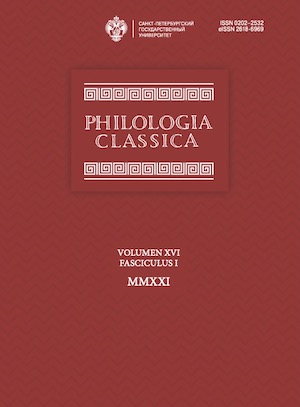On the Confusion of the Terms dualis and communis in Cledonius
DOI:
https://doi.org/10.21638/spbu20.2021.109Abstract
This article attempts to provide an interpretation of a passage on the noun number written by the 5th-century grammarian Cledonius who composed a lemmatised commentary on Donatus’ Ars minor and Ars maior. The passage discussed here is a part of the explanation regarding the noun categories in Ars minor: Numerus, qui unum et plures demonstrat: et communis est numerus, qui et dualis dicitur apud Graecos, ut species facies res. (GL V 10. 19–20). Cledonius’ text confuses two terms dualis and communis, which normally signify different linguistic phenomena. Tim Denecker, whose article covers the history of the term dualis in Latin grammatical treatises, argues that dualis in this passage is indicating a pair and is equated to communis. The aim of the present work is to explain why these two terms have been confused. When comparing Greek and Latin, the Roman grammarians Charisius, Diomedes, Priscian, and Macrobius highlighted the absence of the dual number from Latin, whereas Donatus added it to the singular and plural exemplifying it with two nomina — duo and ambo. Having analysed all of Cledonius’ passages on dualis and communis and compared them with the original text of Donatus, one may notice that Cledonius did not make comments on Donatus’ observations concerning the dual number of duo and ambo. In the author’s view, the grammarian may have opined that the Latin language had no dual number at all, so that in his commentary Latin communis is juxtaposed to Greek dualis and both are opposed to singular and plural.
Keywords:
category of number, dual number, Latin linguistics, Roman grammarians, history of linguistics, Cledonius
Downloads
References
Downloads
Published
How to Cite
Issue
Section
License
Articles of "Philologia Classica" are open access distributed under the terms of the License Agreement with Saint Petersburg State University, which permits to the authors unrestricted distribution and self-archiving free of charge.






